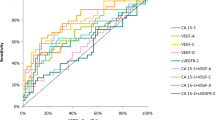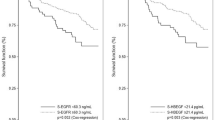Abstract
A pilot study was conducted to assess whether plasma levels of transforming growth factor-β (TGF-β1) might facilitate biological subgrouping of postmenopausal metastatic breast cancer patients, and, accordingly, its applicability in clinical oncology. This study included 29 postmenopausal metastatic breast cancer patients. Plasma TGF-β levels were detected by enzyme-linked immunosorbent assay (ELISA). Estrogen and progesterone receptors were assayed by radioligand binding, in accordance with the recommendation of the EORTC. Concentrations of 17-β estradiol were determined by using ELISA-microwell method (DIALAB). Overall survival was followed for 24 months for each individual patient. Stratification of the patients by ER/PR status showed that 14 patients with estrogen receptor-negative, progesterone receptor-negative carcinomas displayed a statistically significant increase in plasma TGF-β levels when compared to plasma TGF-β levels of 6 patients with ER-positive, PR-positive carcinomas (P=0.04). In this study, 7 out of 14 patients with negative receptors’ status had no plasma TGF-β values overlapping with patients having positive receptors’ status. The TGF-β1 cut-off value was defined as the highest plasma TGF-β level of ER-positive, PR-positive patients: 3.28 ng/ml. This plasma TGF-β cut-off value defined low-risk subgroup of 19 patients (≤ 3.28 ng/ml) and high-risk subgroup of 10 patients (>3.28 ng/ml) (P=0.047). Plasma TGF-β1-related survival was independent of the classical prognostic factors of metastatic breast cancer. Accordingly, a clinical significance of elevated plasma TGF-β levels may be suggested.
Similar content being viewed by others
Abbreviations
- EORTC:
-
European Organization for Research and Treatment of Cancer
- ER:
-
estrogen receptor
- PR:
-
progesterone receptor
References
PM Siegel J Massague (2003) ArticleTitleCytostatic and apoptotic actions of TGF-β in homeostasis and cancer. Clinical & Experimental Metastasis 3 807–20 Occurrence Handle1:CAS:528:DC%2BD3sXotVWkt78%3D
R Derynck RJ Akhurst A Balmain (2001) ArticleTitleTGF-β signaling in tumor suppression and cancer progression. Clinical & Experimental Metastasis 29 117–29 Occurrence Handle1:CAS:528:DC%2BD3MXnsFKgt7c%3D
V Ivanović N Todorović-Raković M Demajo et al. (2003) ArticleTitleElevated plasma levels of transforming growth factor-β1 (TGF-β1) in patients with advanced breast cancer: Association with disease progression. Clinical & Experimental Metastasis 39 454–61
InstitutionalAuthorNameEORTC Breast Cancer Cooperative Group (1980) ArticleTitleRevision of the standards for the assessment of hormone receptors in human breast cancer. Clinical & Experimental Metastasis 9 1513–5
OH Lowry NJ Rosebrough AL Farr et al. (1951) ArticleTitleProtein measurement with the Folin phenol reagent. Clinical & Experimental Metastasis 193 265–75 Occurrence Handle1:CAS:528:DyaG38XhsVyrsw%3D%3D
S Romain BC Laine PM Martin et al. (1995) ArticleTitleOn behalf of the EORTC Receptor Study Group. Clinical & Experimental Metastasis 31 IssueIDA 411–7
EORTC Breast Cancer Cooperative Group. Manual for Clinical Research in Breast Cancer. Leuven, 1991.
M Stockler NRC Wilcken D Ghersi et al. (2000) ArticleTitleSystematic reviews of chemotherapy and endocrine therapy in metastatic breast cancer. Clinical & Experimental Metastasis 26 151–68 Occurrence Handle1:CAS:528:DC%2BD3cXksFSqt7o%3D
V Stearns H Yamauchi DF Hayes (1998) ArticleTitleCirculating tumor markers in breast cancer: Accepted utilities and novel prospects. Clinical & Experimental Metastasis 52 239–59 Occurrence Handle1:STN:280:DyaK1M7mtl2luw%3D%3D
AJ Stewart BR Westley FEB May (1992) ArticleTitleModulation of the proliferative response of breast cancer cells to growth factors by oestrogen. Clinical & Experimental Metastasis 66 640–8 Occurrence Handle1:CAS:528:DyaK3sXnvVagtA%3D%3D
B Tang M Vu T Booker et al. (2003) ArticleTitleTGF-β switches from tumor suppressor to prometastatic factor in a model of breast cancer progression. Clinical & Experimental Metastasis 112 1116–24 Occurrence Handle1:CAS:528:DC%2BD3sXnvFGrsbo%3D
CK Osborne (1998) ArticleTitleSteroid hormone receptors in breast cancer management. Clinical & Experimental Metastasis 51 227–38 Occurrence Handle1:STN:280:DyaK1M7msFCmsg%3D%3D
CA Encarnacion DR Ciocca WL McGuire et al. (1993) ArticleTitleMeasurement of steroid hormone receptors in breast cancer patients on tamoxifen. Clinical & Experimental Metastasis 26 237–46 Occurrence Handle1:STN:280:ByuD2s3nsVA%3D
CL Arteaga AK Tandon DV Hoff ParticleVon et al. (1988) ArticleTitleTransforming growth factor beta: Potential autocrine growth inhibitor of estrogen receptor-negative human breast cancer cells. Clinical & Experimental Metastasis 16 2231–42
KD Amoils WR Bezwoda (1997) ArticleTitleTGF-β1 mRNA expression in clinical breast cancer and its relationship to ER mRNA expression. Clinical & Experimental Metastasis 42 95–101 Occurrence Handle1:CAS:528:DyaK2sXhvV2isbw%3D
MF Fey KW Brunner RW Sonntag (1981) ArticleTitlePrognostic factors in metastatic breast cancer. Clinical & Experimental Metastasis 4 237–47 Occurrence Handle1:STN:280:Bi2D38roslw%3D
P Hietanen M Miettinen J Makinen (1986) ArticleTitleSurvival after first recurrence in breast cancer. Clinical & Experimental Metastasis 22 913–8 Occurrence Handle1:STN:280:BiiD3s%2FkvVA%3D
C Knabbe ME Lippman LM Wakefield et al. (1987) ArticleTitleEvidence that transforming growth factor beta is a hormonally regulated negative growth factor in human breast cancer cells. Clinical & Experimental Metastasis 48 417–28 Occurrence Handle1:CAS:528:DyaL1cXjt1Klug%3D%3D
S Hering D Surig D Freystact et al. (1995) ArticleTitleRegulation of transforming growth factor beta by sex steroids. Clinical & Experimental Metastasis 27 345–51 Occurrence Handle10.1055/s-2007-979976 Occurrence Handle1:CAS:528:DyaK2MXotV2itrY%3D
GC Blobe WP Schiemann HF Lodish (2000) ArticleTitleRole of transforming growth factor b in human disease. Clinical & Experimental Metastasis 342 1350–8 Occurrence Handle1:CAS:528:DC%2BD3cXjtlyksrY%3D
Author information
Authors and Affiliations
Corresponding author
Rights and permissions
About this article
Cite this article
Nikolić-Vukosavljević, D., Todorović-Raković, N., Demajo, M. et al. Plasma TGF-β1-related survival of postmenopausal metastatic breast cancer patients. Clin Exp Metastasis 21, 581–585 (2005). https://doi.org/10.1007/s10585-004-4978-1
Received:
Accepted:
Issue Date:
DOI: https://doi.org/10.1007/s10585-004-4978-1




